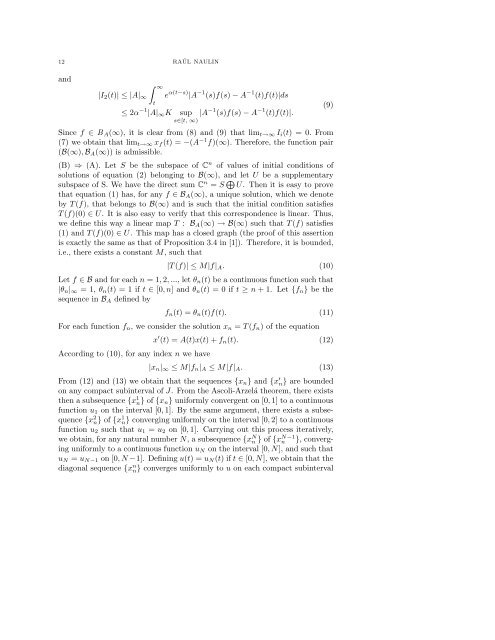A remark on exponential dichotomies
A remark on exponential dichotomies
A remark on exponential dichotomies
You also want an ePaper? Increase the reach of your titles
YUMPU automatically turns print PDFs into web optimized ePapers that Google loves.
12<br />
RAÚL NAULIN<br />
and<br />
∫ ∞<br />
|I 2 (t)| ≤ |A| ∞ e α(t−s) |A −1 (s)f(s) − A −1 (t)f(t)|ds<br />
≤ 2α −1 |A| ∞ K<br />
t<br />
sup<br />
s∈[t, ∞)<br />
|A −1 (s)f(s) − A −1 (t)f(t)|.<br />
Since f ∈ B A (∞), it is clear from (8) and (9) that lim t→∞ I i (t) = 0. From<br />
(7) we obtain that lim t→∞ x f (t) = −(A −1 f)(∞). Therefore, the functi<strong>on</strong> pair<br />
(B(∞), B A (∞)) is admissible.<br />
(B) ⇒ (A). Let S be the subspace of C n of values of initial c<strong>on</strong>diti<strong>on</strong>s of<br />
soluti<strong>on</strong>s of equati<strong>on</strong> (2) bel<strong>on</strong>ging to B(∞), and let U be a supplementary<br />
subspace of S. We have the direct sum C n = S ⊕ U. Then it is easy to prove<br />
that equati<strong>on</strong> (1) has, for any f ∈ B A (∞), a unique soluti<strong>on</strong>, which we denote<br />
by T (f), that bel<strong>on</strong>gs to B(∞) and is such that the initial c<strong>on</strong>diti<strong>on</strong> satisfies<br />
T (f)(0) ∈ U. It is also easy to verify that this corresp<strong>on</strong>dence is linear. Thus,<br />
we define this way a linear map T : B A (∞) → B(∞) such that T (f) satisfies<br />
(1) and T (f)(0) ∈ U. This map has a closed graph (the proof of this asserti<strong>on</strong><br />
is exactly the same as that of Propositi<strong>on</strong> 3.4 in [1]). Therefore, it is bounded,<br />
i.e., there exists a c<strong>on</strong>stant M, such that<br />
(9)<br />
|T (f)| ≤ M|f| A . (10)<br />
Let f ∈ B and for each n = 1, 2, ..., let θ n (t) be a c<strong>on</strong>tinuous functi<strong>on</strong> such that<br />
|θ n | ∞ = 1, θ n (t) = 1 if t ∈ [0, n] and θ n (t) = 0 if t ≥ n + 1. Let {f n } be the<br />
sequence in B A defined by<br />
f n (t) = θ n (t)f(t). (11)<br />
For each functi<strong>on</strong> f n , we c<strong>on</strong>sider the soluti<strong>on</strong> x n = T (f n ) of the equati<strong>on</strong><br />
According to (10), for any index n we have<br />
x ′ (t) = A(t)x(t) + f n (t). (12)<br />
|x n | ∞ ≤ M|f n | A ≤ M|f| A . (13)<br />
From (12) and (13) we obtain that the sequences {x n } and {x ′ n} are bounded<br />
<strong>on</strong> any compact subinterval of J. From the Ascoli-Arzelá theorem, there exists<br />
then a subsequence {x 1 n} of {x n } uniformly c<strong>on</strong>vergent <strong>on</strong> [0, 1] to a c<strong>on</strong>tinuous<br />
functi<strong>on</strong> u 1 <strong>on</strong> the interval [0, 1]. By the same argument, there exists a subsequence<br />
{x 2 n} of {x 1 n} c<strong>on</strong>verging uniformly <strong>on</strong> the interval [0, 2] to a c<strong>on</strong>tinuous<br />
functi<strong>on</strong> u 2 such that u 1 = u 2 <strong>on</strong> [0, 1]. Carrying out this process iteratively,<br />
we obtain, for any natural number N, a subsequence {x N n } of {x N−1<br />
n }, c<strong>on</strong>verging<br />
uniformly to a c<strong>on</strong>tinuous functi<strong>on</strong> u N <strong>on</strong> the interval [0, N], and such that<br />
u N = u N−1 <strong>on</strong> [0, N −1]. Defining u(t) = u N (t) if t ∈ [0, N], we obtain that the<br />
diag<strong>on</strong>al sequence {x n n} c<strong>on</strong>verges uniformly to u <strong>on</strong> each compact subinterval
















